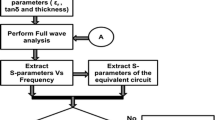Abstract
A new crosstalk reduction technique is proposed, which utilizes defective ground plane structures. With some basic defective ground plane structures, near end crosstalk (NEXT) and far end crosstalk (FEXT) of the coupled lines are reduced, without significant change in signal transmission property. As per the 3X thumb rule, the spacing between two traces must be three times that of the trace width, in order to avoid crosstalk. Without using additional Printed Circuit Board components in the design, a new method is proposed to reduce the crosstalk with the spacing of 0.5 mm and the line width chosen for 50 Ω characteristic impedance. The method proposed has been validated by fabrication and measurements. Both time domain and frequency domain responses are analyzed. Due to the narrow band property of these defective ground structures, the usable bandwidth is narrow. In order to achieve wide usable bandwidth, multiple defective ground structures are used.

Similar content being viewed by others
References
The Institute for Interconnecting and Packaging Electronic Circuits: IPC-2221: Generic Standard on Printed Board Design (1998)
Eged, B.; Novák, I.; Bajor, P.: Crosstalk reduction on stripline printed circuit boards with additional center traces. In: International Symposium on Electromagnetic Compatibility (1994)
Chen H., Zhang Y.-X.: A synthetic design of eliminating crosstalk within MTLS. Prog. Electromagn. Res. 76, 211–221 (2007)
Huang W.T., Lu C.H., Lin D.B.: Design of suppressing crosstalk by vias of serpentine guard trace. PIERS Online 6(4), 360–364 (2010)
Lin, D.-B.; Wang, C.-K.; Lu, C.-H.; Huang, W.-T.: Using rectangular-shape resonators to improve the far-end crosstalk of the coupled microstrip lines. PIERS Proc., 1612–1616 (2011)
Ritchey, L.W.; Zasio, J.; Knack, K.J.: Right the first time. In: A Practical Handbook on High-Speed PCB and System Design, vol. 1, pp. 253–261. Speeding Edge (2003)
Paul, C.R.: Introduction to Electromagnetic Compatibility, pp. 599–601. Wiley, New York (2006)
Thierauf, S.C.: Understanding Signal Integrity, pp. 107–115. Artech House publication, London (2011)
Caniggia, S.; Maradei, F.: Signal Integrity and Radiated Emission of High-Speed Digital Systems, pp. 410–411. Wiley, New York (2008)
Breed, G.: An introduction to defected ground structures in microstrip circuits. High Freq. Electron, pp. 50–54 (2008)
Author information
Authors and Affiliations
Corresponding author
Rights and permissions
About this article
Cite this article
Sindhadevi, M., Malathi, K., Henridass, A. et al. Crosstalk Reduction Using Defective Ground Plane Structures In RF Printed Circuit Boards. Arab J Sci Eng 39, 1107–1116 (2014). https://doi.org/10.1007/s13369-013-0720-0
Received:
Accepted:
Published:
Issue Date:
DOI: https://doi.org/10.1007/s13369-013-0720-0




